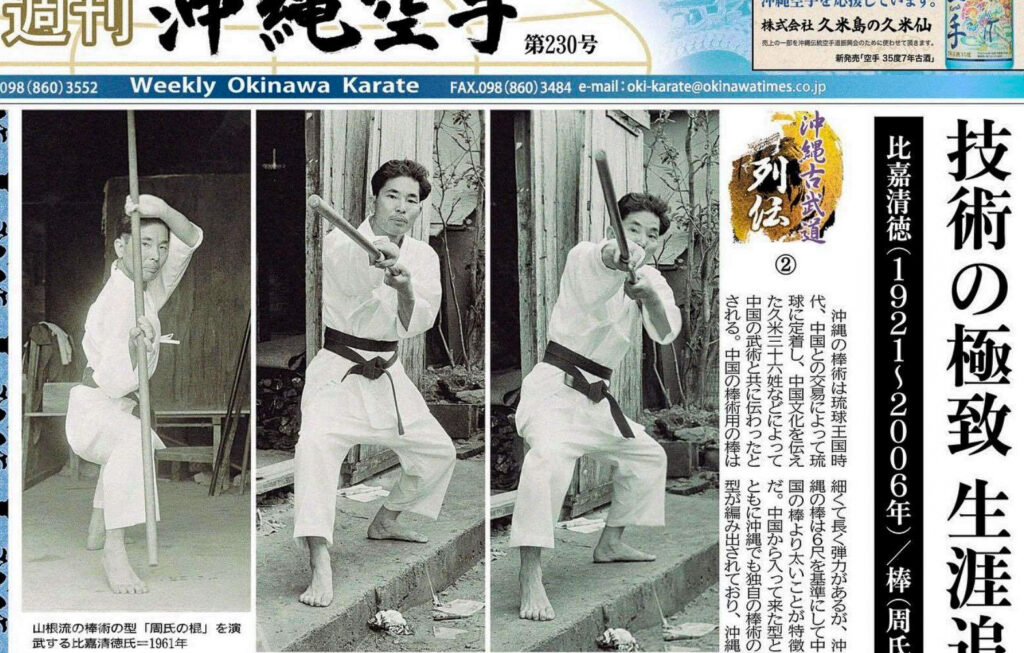(The following is a translation of the following article: Okinawa Times, 29 August 2021: “Weekly Okinawa Karate No. 230 – Okinawa Kobudō Biographies Series 2 – Ultimate Skill – Lifelong Pursuit – Higa Seitoku (1921-2006) – Bō “Shūshi no Kon” – Efforts to expand Karate and Kobudō)
It is said that Okinawan bōjutsu was established in Ryūkyū by trading with China during the Ryūkyū Kingdom era, and that it was introduced along with Chinese martial arts by the 36 Families of Kume, who introduced Chinese culture. Staffs used in Chinese bōjutsu are thin, long and elastic, but Okinawan bō are thicker than Chinese bō and have a standard length of 6 shaku (~182 cm). Along with the kata that came from China, Okinawa has also created its own original kata of bōjutsu, and many kata of traditional ancient martial arts of Okinawa have been inherited.
Born in Shuri Sueyoshi in Naha City, Higa Seitoku (1921-2006) performed kata of karate in a self-taught manner from an early age, but when he was in the first year of the junior high school of the old school system, he began to receive full-fledged personal instruction in karate and kobudō from the warrior (bujin) Kishimoto Sokō. In 1938, he entered Chūō University and refined his karate skills while studying. While attending school, he performed a martial arts demonstration together with Tōyama Kanken in Tsurumi Ward, Yokohama City. In an interview during his lifetime, Higa mentioned that he was inspired by a novel about Miyamoto Musashi to travel about to gain skill (musha shugyō) on a nationwide pilgrimage. Looking back he recalled,
“I slept outdoors, and when it rained I spent the night at a temple, and stood under a waterfall to train my spirit. The practice at that time was a great plus for my daily life.”
After the outbreak of the Pacific War, he began his military service in 1942 and continued his training in between military services, such as performing karate on the island of Sumatra in Indonesia. After returning to Japan in 1947, he opened the Nichigetsukan Karate Dōjō in Kumamoto, striving to popularize karate and kobudō. Two years later, he returned to Okinawa and gathered young people in Shuri Akahira to teach karate and kobudō.
In 1957, he studied under Chinen Masami of Yamane-ryū, which is a prestigious school of bōjutsu. He learned the handling techniques and was given the instructor (shihan) license Number 1 [in Yamane-ryū by Chinen Masami]. He also studied under Uehara Seikichi, the successor of Motobu Udundī, which Higa described as a “profound and infinite skill,” and was awarded the 10th dan hanshi, using one’s bare hands to take away the enemies’ various weapons, and then use the skills of tuiti (toritejutsu) to control them.
Regarding the relationship between karate and kobudō, Higa said,
“It cannot be denied that both the arts of using one’s bare hands and the use of ancient weapons are techniques within the range of the ancient martial arts (kobudō) that have been handed down since ancient times. I learned in practice that the ultimate skill of any martial art is that the sword, karate, spearmanship (sōjutsu), and jūjutsu are based on a general principle of technique.”
In the 1960s he established the Okinawa Kobudō Kyōkai. To further develop the Okinawa Kobudō Kyōkai, he dissolved it and established a new organization, the “Zen Okinawa Karate Kobudō Rengōkai,” and served as its president and continued to make efforts for the development of Okinawan karate and kobudō. In 1995 he founded the Shindō-ryū.
Higa’s photos show his performance of Shūshi no Kon. It is considered to be the basic kata of Yamane-ryū bōjutsu, and it has transformations of technique (henka) such as pretending to strike (uchi) when in fact you thrust (tsuki) or chop (tatakikiru).
Higa Kiyohiko (77), the eldest son of Higa Seitoku and chairman of the Bugei no Kai (martial arts association) who inherited the teaching of karate and kobudō, explained regarding the bōjutsu of Yamane-ryū, “In deflecting (uke) and thrusting (tsuki) with the bō, there is a motion as if expanding and contracting (or, a elastic; flexibile motion). It has a feature that makes it difficult for the other party to control the fighting distance.” Regarding Higa Seitoku during his lifetime, he reflects,
“It’s vile to say that you won or lost. He (Higa Seitoku) set up the Bugei no Kai, saying that it is a “life road” (seidō) to bring to life yourself, and to bring to life others. He eventually came up with his own Shindō-ryū style of using ki to control an opponent.”
Those teachings were inherited by his disciples, and many martial arts artists from all over the world are still visiting the dōjō of Chairman Higa.
© 2021, Andreas Quast. All rights reserved.


